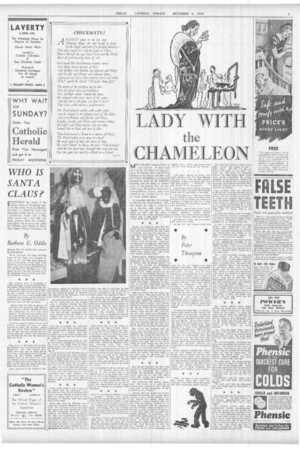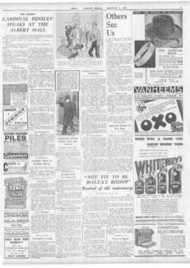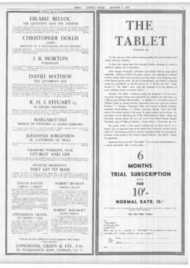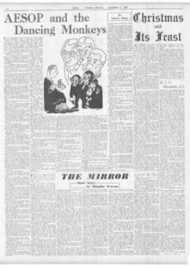Page 7, 9th December 1938
Page 7

Report an error
Noticed an error on this page?If you've noticed an error in this article please click here to report it.
Tags
Share
Related articles
Let Us Al! Join
The Farmer Blaivs His Horn A Ll Through Advent And...
How Christmas Gifts Are Brought To Many Lands
Santa `tried' For Heresy
Will The Real Santa Claus Please Stand Up?
WHO IS SANTA CLAUS ?
EVERYBODY has heard of the Santa Claus of Christmas time. In families where there are children, his name is a household word ; but how many realize that he is not just a benevolent person with a long white beard and a red robe who drops presents down the chimney, but a great and glorious saint called St. Nicholas, once Bishop of Myre, who became famous throughout all
By Barbara E. Oddie
Europe for the wonderful miracles he performed?
It is, perhaps, the most striking proof of his fame that though he lived in the year 300 and England has unfortunately turned away from the Faith, yet the legend still persists in this country that if you ask Santa Claus for something at Christmas you may expect to see it in your stocking or on the Christmas tree or beside your plate on Christmas morning.
* * * The religious side of Christmas is often submerged by the social festivities, and Santa Claus, having developed into a legend, gets asked for all sorts of gifts, but never for that greatest gift of all— the gift of Faith. Yet this is the one thing above all others that he must wish to bestow, for he was a great supporter and defender of the Faith, as the following story from his life will show.
Early in the year 300. the Heresy of Arianism was spreading with alarming rapidity, and the Council of Nice was summoned to deal with the matter. The Council was composed of over 300 Bishops well known in the Christian world, and among them was St. Nicholas, who was Bishop of Myre.
Arius was asked to appear before the Council, and when he came he commenced to define his doctrine, which was that Jesus Christ, being only the Son of God, was not co-equal and coeternal with the Father, and therefore not God himself, but only the best man that ever lived.
* * * Now some of the books tell us that the Bishops were so shocked by these blasphemies that they placed their bands over their ears in order not to hear them, a proceeding which is hardly likely, as you cannot condemn a doctrine if you do not listen to it. But St. Nicholas was so affected by them that he could not contain his indignation, and he advanced upon Arius and felled him to earth with a blow.
Arius appealed to the Emperor, and Constantine handed St. Nicholas over to his brother Bishops to be dealt with. For this display of temper St. Nicholas was deprived of his bishopric, fettered and thrown into prison.
But proof was forthcoming that one can be angry and sin not—always such a consoling thought—for that night there appeared to St. Nicholas Our Lord and Our Lady, who asked him why he was there. He answered, " For love of you," whereupon Our Lord restored to him the book of the Gospels and Our Lady placed the pallium once more upon his shoulders.
* * * Next day the guards were naturally astonished to see their prisoner once more in possession of these distinguishing marks of a Bishop, and they promptly ran to tell their amazing tale to those Bishops who had condemned St. Nicholas.
These, recognizing the hand of God in the matter, immediately repaired to the prison, and going down on their knees begged the Saint's pardon, and St. Nicholas was restored to his former dignity.
As the devotion to St. Nicholas spread to many countries, the name gradually became corrupted. and in some districts became Santa Claus or Santa Claws, while in Holland you can see the name written as Santa Claes; but no matter how the name is written or if there is no name, you can be sure that you are before the representation of St. Nicholas if, at the feet of the saint, you see a tub containing three small children. No other saint is so represented, and it refers to one of the most famous miracles that he performed during his lifetime.
* * * Three small children took refuge for the night with an innkeeper, who, thinking that they looked succulent and tender, cut their throats and salted their flesh for future use as food for his customers—a pleasant little way they had in those days.
Some time later St. Nicholas came along and asked the innkeeper for some food. The Innkeeper said he had some fine salted fish, and showed the Saint the tubs containing the flesh of the children. St. Nicholas took one look at the tubs and immediately reproached the innkeeper for his cruelty. The latter indignantly denied that they contained anything but what he had said already. Thereupon the Saint said a prayer, and I immediately the three children came to as Wore the startled eyes of the inn
keeper, who was so overcome by this amazing occurrence—and no wonder— that he confessed all his crimes of a similar nature and repented of them.
The devotion to St. Nicholas spread very rapidly all over Europe. France, England, Holland, Germany, Russia and Italy all erected churches and shrines in his honour. The two main centres of devotion being Bari, in Italy, where his body lies, and at St. Nicholas de Port, in the beautiful district of Lorraine, where a magnificent Basilica has been erected to house a relic of the Saint, brought from Bari in 1098.
* * *
This church has been the centre of pilgrimage for many famous people. Here it was that St. Joan of Arc came to invoke the aid and honour the relics of the patron saint of Lorraine before commencing her campaign. This was in February, 1429, and the event is commemorated both in the church and in the town. Numerous Emperors came here, including Louis XIII with Richelieu and all his Court. There is a plaque commemorating the fact that In November, 1536, Blessed Pierre Lefeve, St. Francis Xavier, Simon Rodriguez and others came to pray to St. Nicholas before continuing their journey to Venice, where St. Ignatius Loyola awaited them, and together in Rome, in 1539, they Started the Society of Jesus (or Jesuits).
It is impossible to give a list here of some of the miracles that made St. Nicholas sn well known, but it is sufficient proof of his power that even now. in Protestant England, his name lingers on as a giver of all good things, and it Is no doubt because his feast is celebrated on December 6 and he is called the Patron Saint of the Young that he has become so associated with Christmas.
* * * There is spreading in England to-day a " so-called " religion that much resembles the heresy of Arius in that it denies that Jesus Christ is God, or that he ever suffered that we might be saved.
This religion is at present considered rather fashionable, and it is certainly rather a comfortable one, and perhaps it is in this latter point that the greatest danger lies to the longed for Conversion of England.
So when you see a representation of Santa Claus remember St. Nicholas and ask him for the great gift of Faith for yourselves, your friends and your country; and may he deal with England to-day as he dealt with Arius.
blog comments powered by Disqus





















